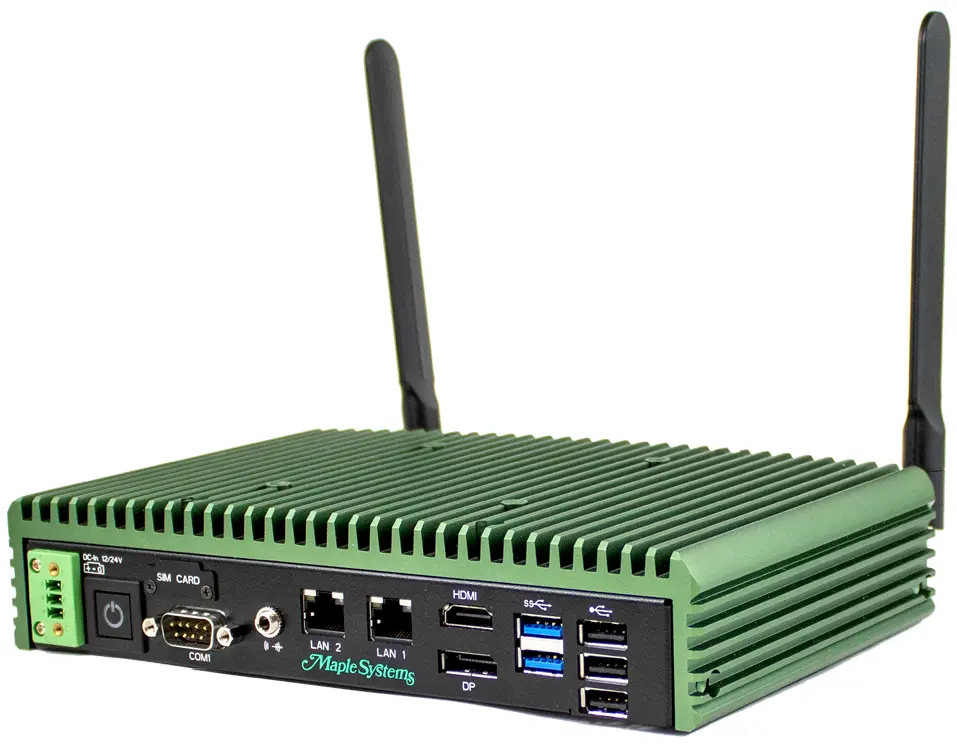Industrial PCs with 4G/LTE Connectivity
Industrial PCs featuring 4G/LTE connectivity ensure seamless communication and long-term operation in challenging environments without stable internet connections. With access provided by cellular data plans just like mobile devices, PCs with cellular connectivity can connect from virtually anywhere. This article discusses the some of the advantages of using Industrial PCs with 4G/LTE connectivity.
Introduction
When installing an Industrial PC in a remote location, connecting your device to the internet can pose unique challenges. Many sites do not have internet access, meaning another solution must be used to enable your PC to communicate. Fortunately, Industrial PCs with 4G/LTE connectivity resolve this by enabling a PC to connect with networks used by mobile devices across the world.
Key Features
- 4G/LTE Hardware: These PCs come with integrated 4G or LTE modules and SIM card slots, allowing them to connect to cellular networks for high-speed data access.
- Antenna Options: Industrial PCs often provide options for external antennas to enhance signal strength and reception, particularly in remote or challenging locations with limited network coverage. Antennas used for 4G/LTE signal are separate from antennas used to connect to a Wi-Fi network.
- Wi-Fi Hotspot: Some models of Industrial PCs also feature Wi-Fi hotspot support. Using the 4G/LTE connection as the gateway to the internet and an onboard Wi-fi kit, some models can project 4G/LTE connectivity through wireless connections to other client devices. In this way, the Industrial PC itself acts as a Wireless Networking Gateway, which helps ease the burden of additional equipment setup and installation, especially in remote locations.
Connecting to a Cellular Network
A good first step to take is to choose the cellular service provider and data plan you will use. Coverage area, transfer rates, compatibility, and budget are just a few of the considerations to keep in mind while making this decision.
GSM Frequency
Not all cellular networks are equal, and a device supporting 4G/LTE may not be able to connect to every 4G network out there. Cellular devices are designed to use certain frequency bands, which may be restricted to specific regions or providers. When buying a PC with 4G support, make sure that the network module is compatible with the networks in the region where you will install it. The following table shows the frequency bands that are commonly used by cellular devices today and the regions they are used in:
For example, if a job site is located in the United States, the network module installed in the PC will need to support the GSM-850 or PCS-1900 frequency bands in order to connect to a mobile network in that region.
SIM/eSIM Installation
Connecting a PC to a 4G/LTE network will require either a physical Subscriber Identity Module (SIM) card or a virtual eSIM. For PCs that have a SIM card or eSIM installed, establishing a connection to a cellular network does not require any external hardware. For PCs that do not have built-in support, you can connect an external cellular modem to enable communication. After inserting the SIM card, the Windows operating system will automatically detect it and update the list of available networks.
To finish establishing a connection to the cellular network, click on the network icon in the lower-right corner of the Windows taskbar to expand the list of available networks, then select the desired cellular network from the list.
The PC should now be able to communicate using the cellular network connection. If the cellular network is not available, or other connection errors occur, see Cellular settings in Windows from Microsoft’s support site for more information and troubleshooting tips.
Adding a Cellular Antenna
PCs with integrated 4G/LTE support will typically include external ports that can be used to connect one or more cellular antennae to improve signal reception.
To connect an antenna, simply screw the antenna into the appropriate port and adjust its position as needed to optimize signal reception. In some cases, multiple antennae may be used to ensure connection stability when in a location that has a particularly weak signal.
Applications
The integration of 4G/LTE connectivity into Industrial PCs offers a range of invaluable advantages. It facilitates real-time communication, ensuring immediate data access and remote-control capabilities within industrial and remote environments. Additionally, 4G/LTE connectivity enables remote monitoring, contributing to increased safety and productivity by reducing the need for physical presence. Industrial PCs with this feature are versatile and useful in sectors such as manufacturing, agriculture, security, and telematics.
Remote Monitoring and Control
Industrial PCs with 4G/LTE enable remote monitoring and control of industrial processes. Often used for equipment like water treatment plants, oil and gas facilities, and utility substations.
Mobile Workstations
These PCs are suitable for applications requiring mobility, such as field service, construction sites, and mobile healthcare facilities. They enable real-time data access and communication in the field.
Video Surveillance
Industrial PCs with 4G/LTE connectivity can facilitate video surveillance applications. Real-time video streaming, storage, and remote monitoring for various security and surveillance systems.
IoT and Edge Computing
PCs with 4G/LTE support can serve as edge computing devices, collecting data from sensors and sending it to the cloud for analysis.
Telematics and Fleet Management
Track vehicles, manage telematics, and oversee fleet management, providing real-time data on vehicle location and performance.
Agriculture
In precision agriculture, these PCs support remote monitoring of agricultural machinery, soil conditions, and crop health, helping optimize farming operations.
Mining and Oil Exploration
In mining and oil exploration, Industrial PCs monitor and control machinery and gather data in remote and rugged environments.
Maple Systems offers 4G/LTE connectivity on select IPCs. See our selection or refer to our datasheets for more information.

